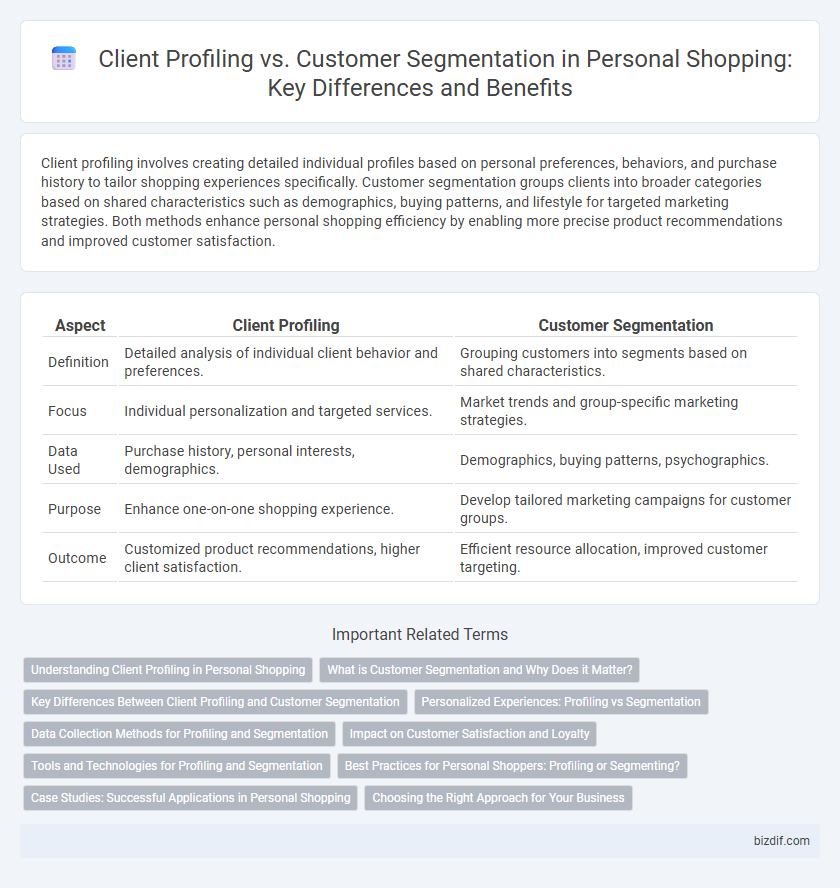Client profiling involves creating detailed individual profiles based on personal preferences, behaviors, and purchase history to tailor shopping experiences specifically. Customer segmentation groups clients into broader categories based on shared characteristics such as demographics, buying patterns, and lifestyle for targeted marketing strategies. Both methods enhance personal shopping efficiency by enabling more precise product recommendations and improved customer satisfaction.
Table of Comparison
| Aspect | Client Profiling | Customer Segmentation |
|---|---|---|
| Definition | Detailed analysis of individual client behavior and preferences. | Grouping customers into segments based on shared characteristics. |
| Focus | Individual personalization and targeted services. | Market trends and group-specific marketing strategies. |
| Data Used | Purchase history, personal interests, demographics. | Demographics, buying patterns, psychographics. |
| Purpose | Enhance one-on-one shopping experience. | Develop tailored marketing campaigns for customer groups. |
| Outcome | Customized product recommendations, higher client satisfaction. | Efficient resource allocation, improved customer targeting. |
Understanding Client Profiling in Personal Shopping
Client profiling in personal shopping involves gathering detailed demographic, psychographic, and behavioral data to create a comprehensive understanding of an individual's preferences and needs. Unlike broader customer segmentation, which groups clients into categories based on shared characteristics, client profiling focuses on tailoring the shopping experience to each person's unique style and buying behavior. Effective client profiling enhances personalized recommendations, improves customer satisfaction, and drives higher conversion rates in personal shopping services.
What is Customer Segmentation and Why Does it Matter?
Customer segmentation involves categorizing a broad consumer base into distinct groups based on shared characteristics such as demographics, behavior, or preferences, enabling personalized marketing and product recommendations. This approach enhances targeting precision, increases customer satisfaction, and boosts sales efficiency by addressing the unique needs of each segment. Understanding customer segmentation is crucial for personal shopping as it allows retailers to tailor experiences and optimize resource allocation for maximum impact.
Key Differences Between Client Profiling and Customer Segmentation
Client profiling involves creating detailed, individualized records based on specific client behaviors, preferences, and purchasing history, allowing for personalized shopping experiences. Customer segmentation categorizes broader groups by shared demographics, interests, or purchasing patterns to target marketing strategies effectively. The key difference lies in client profiling's focus on micro-level, personalized data versus segmentation's macro-level grouping for scalable marketing efforts.
Personalized Experiences: Profiling vs Segmentation
Client profiling creates detailed individual data sets based on personal preferences, purchase history, and behavioral patterns, enabling a highly tailored shopping experience. Customer segmentation groups consumers into categories based on shared characteristics such as demographics or buying habits, allowing for targeted marketing at a broader level. Personalized experiences are enhanced by integrating both approaches, where profiling fine-tunes interactions within the defined segments, increasing relevance and customer satisfaction.
Data Collection Methods for Profiling and Segmentation
Client profiling relies heavily on detailed, individual data collection methods such as surveys, direct interviews, and purchase history analysis to create personalized shopping experiences. Customer segmentation uses aggregated data gathered from sources like demographic analysis, market research, and behavioral tracking to group consumers with similar characteristics. Both approaches require integrating online analytics and offline feedback tools to ensure accurate and dynamic consumer insights for tailored marketing strategies.
Impact on Customer Satisfaction and Loyalty
Client profiling enables personalized recommendations by analyzing individual preferences, improving customer satisfaction through tailored shopping experiences. Customer segmentation groups clients based on shared characteristics, allowing for targeted marketing that enhances loyalty by addressing specific needs efficiently. Implementing both strategies in personal shopping boosts engagement, satisfaction, and long-term retention.
Tools and Technologies for Profiling and Segmentation
Client profiling utilizes CRM software and AI-driven analytics platforms to gather detailed individual data, enabling personalized shopping experiences. Customer segmentation relies on data mining tools and machine learning algorithms to categorize groups based on behavior, demographics, and purchasing patterns. Both approaches integrate big data technologies and predictive analytics for targeted marketing and enhanced decision-making.
Best Practices for Personal Shoppers: Profiling or Segmenting?
Client profiling involves gathering detailed individual data such as preferences, purchase history, and lifestyle to create a personalized shopping experience, while customer segmentation categorizes clients into broader groups based on common characteristics like demographics or buying behavior. Best practices for personal shoppers emphasize combining granular client profiling with strategic customer segmentation to tailor recommendations efficiently and enhance satisfaction. Utilizing data analytics tools and continuous feedback ensures profiles and segments remain accurate and relevant for optimizing personal shopping services.
Case Studies: Successful Applications in Personal Shopping
Client profiling in personal shopping involves creating detailed individual consumer personas based on purchase history, preferences, and behavioral data, enabling personalized recommendations. Customer segmentation categorizes broader groups by demographics or buying patterns to target marketing efforts efficiently. Case studies reveal that integrating both techniques improves client engagement and sales conversion by tailoring experiences at both individual and group levels.
Choosing the Right Approach for Your Business
Client profiling focuses on creating detailed individual customer personas based on behavior, preferences, and purchase history to tailor personalized shopping experiences. Customer segmentation divides the broader market into distinct groups by demographics, buying patterns, or psychographics to target marketing strategies effectively. Choosing the right approach depends on business goals; personalized client profiling suits boutique or high-end retailers, while customer segmentation benefits large-scale operations aiming for efficient market reach.
Client profiling vs customer segmentation Infographic

 bizdif.com
bizdif.com